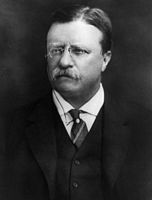United States presidential election, 1912
| |||||||||||||||||||||||||||||||||||||||||||||||||||||||||||||
All 531 electoral votes of the Electoral College 266 electoral votes needed to win | |||||||||||||||||||||||||||||||||||||||||||||||||||||||||||||
|---|---|---|---|---|---|---|---|---|---|---|---|---|---|---|---|---|---|---|---|---|---|---|---|---|---|---|---|---|---|---|---|---|---|---|---|---|---|---|---|---|---|---|---|---|---|---|---|---|---|---|---|---|---|---|---|---|---|---|---|---|---|
| Turnout | 58.8%[1] | ||||||||||||||||||||||||||||||||||||||||||||||||||||||||||||
| |||||||||||||||||||||||||||||||||||||||||||||||||||||||||||||
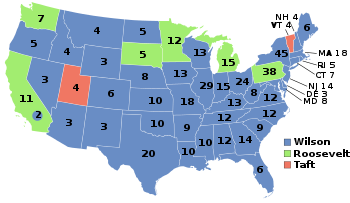  Presidential election results map. Blue denotes those won by Wilson/Marshall, light green denotes those won by Roosevelt/Johnson, red denotes states won by Taft/Butler. Numbers indicate the number of electoral votes allotted to each state. | |||||||||||||||||||||||||||||||||||||||||||||||||||||||||||||
| |||||||||||||||||||||||||||||||||||||||||||||||||||||||||||||
The United States presidential election of 1912 was the 32nd quadrennial presidential election, held on Tuesday, November 5, 1912. Democratic Governor Woodrow Wilson of New Jersey unseated incumbent Republican President William Howard Taft and defeated Former President Theodore Roosevelt, who ran as the Progressive Party ("Bull Moose") nominee. Roosevelt remains the only third party presidential candidate in U.S. history to finish better than third in the popular or electoral vote.
Roosevelt had served as president from 1901 to 1909, and Taft had won the 1908 Republican presidential nomination with Roosevelt's support. Displeased with Taft's actions as president, Roosevelt challenged Taft at the 1912 Republican National Convention. After Taft and his conservative allies narrowly prevailed at the Republican convention, Roosevelt rallied his progressive supporters and launched a third party bid. Backed by William Jennings Bryan and other progressives, Wilson won the Democratic Party's presidential nomination on the 46th ballot, defeating Speaker of the House Champ Clark and several other candidates. Meanwhile, the Socialist Party renominated its perennial standard-bearer, Eugene V. Debs.
The election of 1912 was bitterly contested by three individuals, Wilson, Roosevelt, and Taft, who all had or would serve as president. Roosevelt's "New Nationalism" platform called for social insurance programs, an eight-hour workday, and a strong federal role in regulating the economy. Wilson's "New Freedom" platform called for tariff reform, banking reform, and a new antitrust law. Knowing that he had little chance of victory, Taft conducted a subdued campaign based on his own platform of "progressive conservatism." Debs claimed that the other three candidates were largely financed by trusts and tried to galvanize support behind his socialist policies.
The Progressive party was nicknamed the "Bull Moose Party" after journalists quoted Roosevelt saying that he felt "fit as a bull moose" following an assassination attempt on the campaign trail shortly after the new party was formed.[2]
Wilson carried 40 states and won a large majority of the electoral vote, taking advantage of the split in the Republican Party. He was the first Democrat to win a presidential election since 1892, and would be one of just two Democratic presidents to serve between the Civil War and the onset of the Great Depression. Roosevelt won 88 electoral votes, while Taft carried just two states, taking 8 electoral votes. Wilson won 41.8% of the national popular vote, while Roosevelt won 27%, Taft 23%, and Debs 6%.
Contents
1 Background
2 Nominations
2.1 Republican Party nomination
2.1.1 Candidates gallery
2.2 Progressive Party
2.3 Democratic Party nomination
2.3.1 Candidates gallery
2.4 Socialist Party nomination
3 General election
3.1 Campaign
3.2 Tariffs and Republican Party split
3.3 Results
3.4 Geography of results
3.4.1 Cartographic gallery
3.5 Results by state
3.6 Close states
3.6.1 Statistics
4 See also
5 Notes
6 References
7 Further reading
7.1 Primary sources
8 External links
Background
Republican President Theodore Roosevelt had declined to run for re-election in 1908 in fulfillment of a pledge to the American people not to seek a second full term. Roosevelt's first term as president (1901–1905) was incomplete, as he succeeded to the office upon the assassination of William McKinley; it was only his second term (1905–1909) that encompassed four full years. He had tapped Secretary of War William Howard Taft to become his successor, and Taft defeated Democrat William Jennings Bryan in the general election.
During Taft's administration, a rift grew between Roosevelt and Taft as they became the leaders of the Republican Party's two wings: the progressives, led by Roosevelt, and the conservatives, led by Taft. The progressive Republicans favored restrictions on the employment of women and children, promoted ecological conservation, and were more sympathetic toward labor unions. The progressive Republicans were also in favor of the popular election of federal and state judges and opposed to having judges appointed by the president or state governors. The conservative Republicans were in support of high tariffs on imported goods to encourage consumers to buy American-made products (as were most progressive Republicans), favored business leaders over labor unions, and were generally opposed to the popular election of judges.
By 1910 the split between the two wings of the Republican Party was deep, and this, in turn, caused Roosevelt and Taft to turn against one another, despite their personal friendship. The 1910 Midterm elections proved to be rather rough for the Republicans which seemed to further cement the growing divide among the party. Taft's popularity among Progressives collapsed when he supported the Payne-Aldrich Tariff Act in 1909,[3] abandoned Roosevelt's anti-trust policy[4] and fired popular conservationist Gifford Pinchot as head of the Bureau of Forestry in 1910.[5]
Nominations
Republican Party nomination
 Republican Party Ticket, 1912 | |||||||||||||||||||||||||||||
William Howard Taft | James S. Sherman | ||||||||||||||||||||||||||||
|---|---|---|---|---|---|---|---|---|---|---|---|---|---|---|---|---|---|---|---|---|---|---|---|---|---|---|---|---|---|
for President | for Vice President | ||||||||||||||||||||||||||||
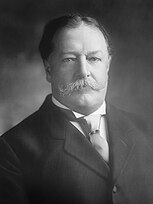 | 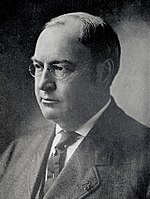 | ||||||||||||||||||||||||||||
27th President of the United States (1909–1913) | 27th Vice President of the United States (1909–1912) | ||||||||||||||||||||||||||||
Campaign | |||||||||||||||||||||||||||||
Republican candidates:
William Howard Taft, President of the United States
Theodore Roosevelt, former President of the United States from New York
Robert M. La Follette, Senator from Wisconsin
Candidates gallery

President William Howard Taft

Theodore Roosevelt from New York

Senator Robert M. La Follette from Wisconsin

A Punch cartoon by Leonard Raven-Hill, depicting the perceived aggression between Taft and Roosevelt.
For the first time, significant numbers of delegates to the national conventions were elected in presidential preference primaries. Primary elections were advocated by the progressive faction of the Republican Party, which wanted to break the control of political parties by bosses. Altogether, twelve states held Republican primaries. Robert M. La Follette won two of the first four primaries (North Dakota and Wisconsin). Beginning with his runaway victory in Illinois on April 9, however, Roosevelt won nine of the last ten presidential primaries (in order, Illinois, Pennsylvania, Nebraska, Oregon, Maryland, California, Ohio, New Jersey, and South Dakota), losing only Massachusetts to Taft.[6] As a sign of his great popularity, Roosevelt even carried Taft's home state of Ohio.
The Republican Convention was held in Chicago from June 18 to 22. Taft, however, had begun to gather delegates earlier, and the delegates chosen in the primaries were a minority. Taft had the support of the bulk of the party organizations in the Southern states. These states had voted solidly Democratic in every presidential election since 1880, and Roosevelt objected that they were given one-quarter of the delegates when they would contribute nothing to a Republican victory (as it turned out, delegates from the former Confederate states supported Taft by a 5 to 1 margin). When the convention gathered, Roosevelt challenged the credentials of nearly half of the delegates.[citation needed] By that time, however, it was too late. The delegates chose Elihu Root — once Roosevelt's top ally — to serve as chairman of the convention. Afterwards, the delegates seated Taft delegations in Alabama, Arizona, and California on tight votes of 597-472, 564-497, and 542-529, respectively. After losing California, where Roosevelt had won the primary, the progressive delegates gave up hope. They voted "present" on most succeeding roll calls. Not since the 1872 election had there been a major schism in the Republican party. Now, with the Democrats holding about 45% of the national vote, any schism would be fatal. Roosevelt's only hope at the convention was to form a "stop-Taft" alliance with La Follette, but Roosevelt had alienated La Follette, and the alliance could not form.
Unable to tolerate the personal humiliation he suffered at the hands of Taft and the Old Guard, and refusing to entertain the possibility of a compromise candidate, Roosevelt struck back hard. On the evening of June 22, 1912, Roosevelt asked his supporters to leave the convention. Roosevelt maintained that President Taft had allowed fraudulent seating of delegates to capture the presidential nomination from progressive forces within the Party. Thus, with the support of convention chairman Elihu Root, Taft's supporters outvoted Roosevelt's men, and the convention renominated incumbents William Howard Taft and James S. Sherman, making Sherman the first sitting vice-president to be nominated for re-election since John C. Calhoun in 1828.
Presidential Ballot[7][8][9] | |
| William Taft | 561 |
|---|---|
| Theodore Roosevelt | 107 |
| Robert La Follette | 41 |
| Albert B. Cummins | 17 |
| Charles Evans Hughes | 2 |
| Present, not voting | 344 |
| Absent | 6 |
Vice Presidential Ballot | |
| James S. Sherman | 596 |
|---|---|
| William Borah | 21 |
| Charles Edward Merriam | 20 |
| Herbert S. Hadley | 14 |
| Albert J. Beveridge | 2 |
Progressive Party
 Progressive Party Ticket, 1912 | |||||||||||||||||||||||||||||
Theodore Roosevelt | Hiram Johnson | ||||||||||||||||||||||||||||
|---|---|---|---|---|---|---|---|---|---|---|---|---|---|---|---|---|---|---|---|---|---|---|---|---|---|---|---|---|---|
for President | for Vice President | ||||||||||||||||||||||||||||
 |  | ||||||||||||||||||||||||||||
26th President of the United States (1901–1909) | 23rd Governor of California (1911–1917) | ||||||||||||||||||||||||||||
Campaign | |||||||||||||||||||||||||||||
Progressive candidate:
Theodore Roosevelt, former President of the United States, from New York
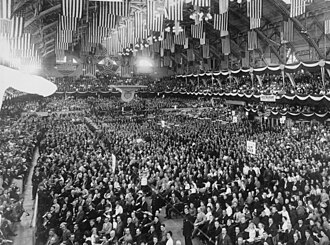
Progressive convention, 1912
Republican progressives reconvened in Chicago and endorsed the formation of a national progressive party. When formally launched later that summer, the new Progressive Party chose Roosevelt as its presidential nominee and Governor Hiram Johnson from California as his vice presidential running mate. Questioned by reporters, Roosevelt said he felt as strong as a "bull moose". Henceforth known as the "Bull Moose Party," the Progressives promised to increase federal regulation and protect the welfare of ordinary people.
The party was funded by publisher Frank Munsey and its executive secretary George Walbridge Perkins, an employee of banker J. P. Morgan and International Harvester. Perkins blocked an anti-trust plank, shocking reformers who thought of Roosevelt as a true trust-buster. The delegates to the convention sang the hymn "Onward, Christian Soldiers" as their anthem. In a famous acceptance speech, Roosevelt compared the coming presidential campaign to the Battle of Armageddon and stated that the Progressives were going to "battle for the LORD." However, many of the nation's newspapers, which tended to be pro-Republican, harshly depicted Roosevelt as an egotist who was only running for president to spoil Taft's chances and feed his vanity.
Democratic Party nomination
 Democratic Party Ticket, 1912 | |||||||||||||||||||||||||||||
Woodrow Wilson | Thomas R. Marshall | ||||||||||||||||||||||||||||
|---|---|---|---|---|---|---|---|---|---|---|---|---|---|---|---|---|---|---|---|---|---|---|---|---|---|---|---|---|---|
for President | for Vice President | ||||||||||||||||||||||||||||
 | 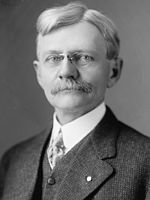 | ||||||||||||||||||||||||||||
34th Governor of New Jersey (1911–1913) | 27th Governor of Indiana (1909–1913) | ||||||||||||||||||||||||||||
Campaign | |||||||||||||||||||||||||||||
Democratic candidates:
Woodrow Wilson, Governor of New Jersey
Champ Clark, Speaker of the House from Missouri
Judson Harmon, Governor of Ohio
Oscar Underwood, House Majority Leader from Alabama
Eugene Foss, Governor of Massachusetts
Thomas R. Marshall, Governor of Indiana
Simeon E. Baldwin, Governor of Connecticut
Candidates gallery
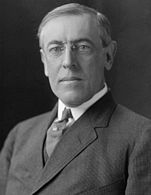
Governor Woodrow Wilson of New Jersey
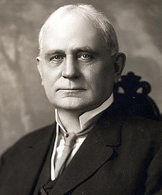
Speaker of the House Champ Clark from Missouri

Governor Judson Harmon of Ohio

House Majority Leader Oscar Underwood from Alabama

Governor Eugene Foss of Massachusetts

Governor Thomas R. Marshall of Indiana

Governor Simeon E. Baldwin of Connecticut
The Democratic Convention was held in Baltimore, Maryland, from June 25 to July 2. It proved to be one of the more memorable presidential conventions of the twentieth century. Initially, the frontrunner appeared to be Champ Clark of Missouri, the Speaker of the House, and Clark did receive the largest number of delegate votes early in the balloting. However, he was unable to get the two-thirds majority required to win the nomination. His chances were hurt when Tammany Hall, the powerful and corrupt Democratic political machine in New York City, threw its support behind Clark. Instead of helping him, this led William Jennings Bryan, the three-time Democratic presidential candidate and still the leader of the party's progressives, to turn against Clark as the candidate of "Wall Street". Bryan instead threw his support to New Jersey Governor Woodrow Wilson, who had consistently finished second to Clark on each ballot, and who was regarded as a moderate reformer. Wilson had nearly given up hope that he could be nominated, and he was on the verge of having a concession speech read for him at the convention that would free his delegates to vote for someone else. Bryan's defection from Clark to Wilson led many other delegates to do the same, and Wilson gradually gained strength while Clark's support dwindled. Wilson finally received the nomination on the 46th ballot.
Thomas R. Marshall, the Governor of Indiana, who had swung his state's delegate votes to Wilson in later ballots, was named as Wilson's running mate.
| (1-24) | Presidential Ballot | ||||||||||||||||||||||||
|---|---|---|---|---|---|---|---|---|---|---|---|---|---|---|---|---|---|---|---|---|---|---|---|---|---|
| 1st | 2nd | 3rd | 4th | 5th | 6th | 7th | 8th | 9th | 10th | 11th | 12th | 13th | 14th | 15th | 16th | 17th | 18th | 19th | 20th | 21st | 22nd | 23rd | 24th | ||
| Woodrow Wilson | 324 | 339.75 | 345 | 349.5 | 351 | 354 | 352.5 | 351.5 | 352.5 | 350.5 | 354.5 | 354 | 356 | 361 | 362.5 | 362.5 | 362.5 | 361 | 358 | 388.5 | 395.5 | 396.5 | 399 | 402.5 | |
| Champ Clark | 440.5 | 446.5 | 441 | 443 | 443 | 445 | 449.5 | 448.5 | 452 | 556 | 554 | 547.5 | 554.5 | 553 | 552 | 551 | 545 | 535 | 532 | 512 | 508 | 500.5 | 497.5 | 496 | |
| Judson Harmon | 148 | 141 | 140.5 | 136.5 | 141.5 | 135 | 129.5 | 130 | 127 | 31 | 29 | 29 | 29 | 29 | 29 | 29 | 29 | 29 | 29 | 29 | 29 | 0 | 0 | 0 | |
| Oscar Underwood | 117.5 | 111.25 | 114.5 | 112 | 119.5 | 121 | 123.5 | 123 | 122.5 | 117.5 | 118.5 | 123 | 115.5 | 111 | 110.5 | 112.5 | 112.5 | 125 | 130 | 121.5 | 118.5 | 115 | 114.5 | 115.5 | |
| Eugene Foss | 0 | 0 | 0 | 0 | 0 | 0 | 0 | 0 | 0 | 0 | 0 | 0 | 2 | 0 | 0 | 0 | 0 | 0 | 1 | 2 | 5 | 43 | 45 | 43 | |
| Thomas R. Marshall | 31 | 31 | 31 | 31 | 31 | 31 | 31 | 31 | 31 | 31 | 30 | 30 | 30 | 30 | 30 | 30 | 30 | 30 | 30 | 30 | 30 | 30 | 30 | 30 | |
| Simeon E. Baldwin | 22 | 14 | 14 | 14 | 0 | 0 | 0 | 0 | 0 | 0 | 0 | 0 | 0 | 0 | 0 | 0 | 0 | 0 | 0 | 0 | 0 | 0 | 0 | 0 | |
| William J. Bryan | 1 | 2 | 1 | 0 | 0 | 1 | 1 | 1 | 1 | 1 | 1 | 1 | 1 | 2 | 2 | 1 | 1 | 1 | 7 | 1 | 1 | 1 | 1 | 1 | |
| John W. Kern | 0 | 0 | 1 | 2 | 2 | 1 | 1 | 1 | 1 | 1 | 1 | 1 | 0 | 2 | 2 | 2 | 4.5 | 3.5 | 1 | 1 | 1 | 1 | 0 | 0 | |
| Ollie M. James | 0 | 0 | 0 | 0 | 0 | 0 | 0 | 1 | 0 | 0 | 0 | 0 | 0 | 0 | 0 | 0 | 0 | 0 | 0 | 3 | 0 | 0 | 0 | 0 | |
| William Sulzer | 2 | 2 | 0 | 0 | 0 | 0 | 0 | 0 | 0 | 0 | 0 | 0 | 0 | 0 | 0 | 0 | 0 | 0 | 0 | 0 | 0 | 0 | 0 | 0 | |
| William J. Gaynor | 0 | 0 | 0 | 0 | 0 | 0 | 0 | 1 | 1 | 0 | 0 | 0 | 0 | 0 | 0 | 0 | 0 | 0 | 0 | 0 | 0 | 1 | 1 | 0 | |
| J. Hamilton Lewis | 0 | 0 | 0 | 0 | 0 | 0 | 0 | 0 | 0 | 0 | 0 | 0 | 0 | 0 | 0 | 0 | 0 | 0 | 0 | 0 | 0 | 0 | 0 | 0 | |
| Blank | 2 | 0.5 | 0 | 0 | 0 | 0 | 0 | 0 | 0 | 0 | 0 | 2.5 | 0 | 0 | 0 | 0 | 3.5 | 3.5 | 0 | 0 | 0 | 0 | 0 | 0 | |
| (25-46) | Presidential Ballot | ||||||||||||||||||||||
|---|---|---|---|---|---|---|---|---|---|---|---|---|---|---|---|---|---|---|---|---|---|---|---|
| 25th | 26th | 27th | 28th | 29th | 30th | 31st | 32nd | 33rd | 34th | 35th | 36th | 37th | 38th | 39th | 40th | 41st | 42nd | 43rd | 44th | 45th | 46th | Unanimous | |
| Woodrow Wilson | 405 | 407.5 | 406.5 | 437.5 | 436 | 460 | 475.5 | 477.5 | 477.5 | 479.5 | 494.5 | 496.5 | 496.5 | 498.5 | 501.5 | 501.5 | 499.5 | 494 | 602 | 629 | 633 | 990 | 1,088 |
| Champ Clark | 469 | 463.5 | 469 | 468.5 | 468.5 | 455 | 446.5 | 446.5 | 447.5 | 447.5 | 433.5 | 434.5 | 432.5 | 425 | 422 | 423 | 424 | 430 | 329 | 306 | 306 | 84 | |
| Judson Harmon | 29 | 29 | 29 | 29 | 29 | 19 | 17 | 14 | 29 | 29 | 29 | 29 | 29 | 29 | 29 | 28 | 27 | 27 | 28 | 27 | 25 | 12 | |
| Oscar Underwood | 108 | 112.5 | 112 | 112.5 | 112 | 121.5 | 116.5 | 119.5 | 103.5 | 101.5 | 101.5 | 98.5 | 100.5 | 106 | 106 | 106 | 106 | 104 | 98.5 | 99 | 97 | 0 | |
| Eugene Foss | 43 | 43 | 38 | 38 | 38 | 30 | 30 | 28 | 28 | 28 | 28 | 28 | 28 | 28 | 28 | 28 | 28 | 28 | 27 | 27 | 27 | 0 | |
| Thomas R. Marshall | 30 | 30 | 30 | 0 | 0 | 0 | 0 | 0 | 0 | 0 | 0 | 0 | 0 | 0 | 0 | 0 | 0 | 0 | 0 | 0 | 0 | 0 | |
| Simeon E. Baldwin | 0 | 0 | 0 | 0 | 0 | 0 | 0 | 0 | 0 | 0 | 0 | 0 | 0 | 0 | 0 | 0 | 0 | 0 | 0 | 0 | 0 | 0 | |
| William J. Bryan | 1 | 1 | 1 | 1 | 0 | 0 | 0 | 0 | 0 | 0 | 0 | 0 | 0 | 0 | 0 | 0 | 1 | 0.5 | 1 | 0 | 0 | 0 | |
| John W. Kern | 0 | 0 | 0 | 1 | 4 | 2 | 2 | 2 | 2 | 2 | 1 | 1 | 1 | 1 | 1 | 1 | 1 | 1 | 1 | 0 | 0 | 0 | |
| Ollie M. James | 3 | 0 | 0 | 0 | 0 | 0 | 0 | 0 | 0 | 0 | 0 | 0 | 0 | 0 | 0 | 0 | 0 | 1 | 0 | 0 | 0 | 0 | |
| William Sulzer | 0 | 0 | 0 | 0 | 0 | 0 | 0 | 0 | 0 | 0 | 0 | 0 | 0 | 0 | 0 | 0 | 0 | 0 | 0 | 0 | 0 | 0 | |
| William J. Gaynor | 0 | 0 | 0 | 0 | 0 | 0 | 0 | 0 | 0 | 0 | 0 | 0 | 0 | 0 | 0 | 0 | 1 | 1 | 0 | 0 | 0 | 0 | |
| J. Hamilton Lewis | 0 | 0 | 0 | 0 | 0 | 0 | 0 | 0 | 0 | 0 | 0 | 0 | 0 | 0 | 0 | 0 | 0 | 1 | 0 | 0 | 0 | 0 | |
| Blank | 0 | 1.5 | 2.5 | 0.5 | 0.5 | 0.5 | 0.5 | 0.5 | 0.5 | 0.5 | 0.5 | 0.5 | 0.5 | 0.5 | 0.5 | 0.5 | 0.5 | 0.5 | 1.5 | 0 | 0 | 2 | |
Vice Presidential Ballot | |||
| 1st | 2nd | Unanimous | |
|---|---|---|---|
| Thomas R. Marshall | 389 | 644.5 | 1,088 |
| John Burke | 304.67 | 386.33 | |
| George E. Chamberlain | 157 | 12.5 | |
| Elmore W. Hurst | 78 | 0 | |
| James H. Preston | 58 | 0 | |
| Martin J. Wade | 26 | 0 | |
| William F. McCombs | 18 | 0 | |
| John E. Osborne | 8 | 0 | |
| William Sulzer | 3 | 0 | |
| Blank | 46.33 | 44.67 | |
Socialist Party nomination
 Socialist Party Ticket, 1912 | |||||||||||||||||||||||||||||
Eugene V. Debs | Emil Seidel | ||||||||||||||||||||||||||||
|---|---|---|---|---|---|---|---|---|---|---|---|---|---|---|---|---|---|---|---|---|---|---|---|---|---|---|---|---|---|
for President | for Vice President | ||||||||||||||||||||||||||||
 |  | ||||||||||||||||||||||||||||
| Former Indiana State Senator (1885–1887) | 36th Mayor of Milwaukee (1910–1912) | ||||||||||||||||||||||||||||
Campaign | |||||||||||||||||||||||||||||
Socialist candidates:
Eugene V. Debs, former State Representative from Indiana
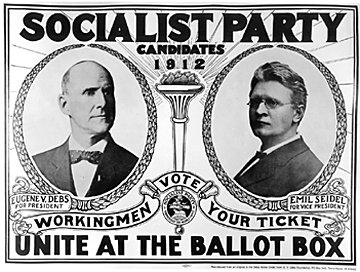
Eugene V. Debs' 6% was an all-time high for the Socialist Party
The Socialist Party of America was a highly factionalized coalition of local parties based in industrial cities and usually was rooted in ethnic communities, especially German and Finnish. It also had some support in old Populist rural and mining areas in the West, especially Oklahoma. By 1912, the party claimed more than a thousand locally elected officials in 33 states and 160 cities, especially the Midwest. Eugene V. Debs had run for president in 1900, 1904, and 1908, primarily to encourage the local effort, and he did so again in 1912 and from prison in 1920.[10]
The conservatives, led by Victor L. Berger from Milwaukee, promoted progressive causes of efficiency and an end to corruption, nicknamed "gas and water socialism." Their opponents were the radicals who wanted to overthrow capitalism, tried to infiltrate labor unions, and sought to cooperate with the Industrial Workers of the World ("the Wobblies"). With few exceptions, the party had weak or nonexistent links to local labor unions. Immigration was an issue—the radicals saw immigrants as fodder for the war with capitalism, while conservatives complained that they lowered wage rates and absorbed too many city resources. Many of these issues had been debated at the First National Congress of the Socialist Party in 1910, and they were debated again at the national convention in Indianapolis in 1912. At the latter, the radicals won an early test by seating Bill Haywood on the Executive Committee, sending encouragement to western "Wobblies", and passed a resolution seeming to favor industrial unionism. The conservatives counterattacked by amending the party constitution to expel any socialists who favored industrial sabotage or syndicalism (that is, the IWW), and who refused to participate in American elections. They adopted a conservative platform calling for cooperative organization of prisons, a national bureau of health, abolition of the Senate and the presidential veto. Debs did not attend; he saw his mission as keeping the disparate units together in the hope that someday a common goal would be found.
General election
Campaign
The 1912 presidential campaign was bitterly contested. Vice-President James S. Sherman died in office on October 30, 1912, less than a week before the election, leaving Taft without a running mate. (Nicholas M. Butler was designated to receive electoral votes that would have been cast for Sherman.) With the Republican Party divided, Wilson captured the presidency handily on November 5.[citation needed]

Republican campaign postcard charging a Democratic administration would remove pensioners from the rolls
While Roosevelt was campaigning in Milwaukee on October 14, 1912, a saloonkeeper from New York, John Flammang Schrank, shot him, but the bullet lodged in his chest only after penetrating both his steel eyeglass case and a 50-page single-folded copy of the speech titled "Progressive Cause Greater Than Any Individual", he was to deliver, carried in his jacket pocket. Schrank was immediately disarmed, captured and might have been lynched had Roosevelt not shouted for Schrank to remain unharmed.[11] Roosevelt assured the crowd he was all right, then ordered police to take charge of Schrank and to make sure no violence was done to him.[12] Roosevelt, as an experienced hunter and anatomist, correctly concluded that since he was not coughing blood, the bullet had not reached his lung, and he declined suggestions to go to the hospital immediately. Instead, he delivered his scheduled speech with blood seeping into his shirt.[13] He spoke for 90 minutes before completing his speech and accepting medical attention. His opening comments to the gathered crowd were, "Ladies and gentlemen, I don't know whether you fully understand that I have just been shot, but it takes more than that to kill a Bull Moose."[14][15][15][citation needed] Afterwards, probes and an x-ray showed that the bullet had lodged in Roosevelt's chest muscle, but did not penetrate the pleura. Doctors concluded that it would be less dangerous to leave it in place than to attempt to remove it, and Roosevelt carried the bullet with him for the rest of his life.[16][17] In later years, when asked about the bullet inside him, Roosevelt would say, "I do not mind it any more than if it were in my waistcoat pocket."[18]
Both Taft and Democratic nominee Woodrow Wilson suspended their own campaigning until Roosevelt recovered and resumed his. When asked if the shooting would affect his election campaign, he said to the reporter "I'm fit as a bull moose", which inspired the party's emblem.[19] He spent two weeks recuperating before returning to the campaign trail.
The election of 1912 is considered the high tide of progressive politics. Had either Roosevelt or Taft stayed out of the race, a Republican victory would have been assured.[citation needed]
The Socialists had little money; Debs' campaign cost only $66,000, mostly for 3.5 million leaflets and travel to rallies organized by local groups. His biggest event was a speech to 15,000 supporters in New York City. The crowd sang "La Marseillaise" and "The Internationale" as Emil Seidel, the vice- presidential candidate, boasted, "Only a year ago workingmen were throwing decayed vegetables and rotten eggs at us but now all is changed... Eggs are too high. There is a great giant growing up in this country that will someday take over the affairs of this nation. He is a little giant now but he is growing fast. The name of this little giant is socialism." Debs said that only the socialists represented labor. He condemned "Injunction Bill Taft" and ridiculed Roosevelt as "a charlatan, mountebank, and fraud, and his Progressive promises and pledges as the mouthings of a low and utterly unprincipled self seeker and demagogue." Debs insisted that the Democrats, Progressives, and Republicans alike were financed by the trusts. Party newspapers spread the word—there were five English-language and eight foreign-language dailies along with 262 English and 36 foreign-language weeklies. The labor union movement, however, largely rejected Debs and supported Wilson.[citation needed]

Roosevelt mixing "radical" ingredients in his speeches in this 1912 editorial cartoon by Karl K. Knecht (1883–1972) in the Republican Evansville Courier newspaper
Roosevelt conducted a vigorous national campaign for the Progressive Party, denouncing the way the Republican nomination had been "stolen". He bundled together his reforms under the rubric of "The New Nationalism" and stumped the country for a strong federal role in regulating the economy and chastising bad corporations. Wilson supported a policy called "The New Freedom". This policy was based mostly on individualism instead of a strong government. Taft campaigned quietly, and spoke of the need for judges to be more powerful than elected officials. The departure of the more progressive Republicans left the conservative Republicans even more firmly in control of their party until 1916, when many progressives returned. Much of the Republican effort was designed to discredit Roosevelt as a dangerous radical, but this had little effect.[citation needed]
Tariffs and Republican Party split
Before the ratification of the Sixteenth United States Constitutional Amendment (1913), the funding of the United States government heavily relied upon tariffs. Tariffs are a direct taxation of raw materials and manufactured goods with regard to trade. This issue was key in fracturing the Republican Party. Early in his term, President Taft had promised to stand for a less protectionist tariff bill. Protectionism was major policy of the business oriented Republican Party.[20]
After Congressional deliberation, the Payne-Aldrich Act (1909) was passed and signed by President Taft. The Payne-Aldrich Act would not satisfy the growing economic sectionalism of the country; the Northwest and South wanted tariff reductions on manufactured goods, as well as more raw materials to be added to the 'free-list' (non-taxed goods)[21] The new tariff policy would increase duties; going against President Taft's promises, it further alienated the progressive wing of the Republican Party. President Taft's inability to satisfy both wings of his party would create a political opening for his predecessor, Theodore Roosevelt, to make a run for the presidency. Theodore Roosevelt would rally progressives with speeches to pressure the political establishment. In regards to the existing tariff policy, Theodore Roosevelt would vouch for "...an expert tariff commission, wholly removed from the possibility of political pressure or of improper business influence.".[22]
Results

Results by county explicitly indicating the percentage for the winning candidate. Shades of blue are for Wilson (Democratic), shades of green are for Roosevelt (Progressive), shades of red are for Taft (Republican), shades of yellow are for Debs (Socialist), light grey indicates zero recorded votes and dark grey indicates territories not elevated to statehood
The impact of the third-party vote is indicated by the fact that few states were carried by a majority of the popular vote. Taft carried two states (Utah and Vermont), Roosevelt six, and Wilson forty. Taft carried no state with a popular majority, Roosevelt one (South Dakota, where there was no Republican ticket), and Wilson eleven, all of them states of the former Confederacy. More than two-thirds of Wilson's total vote was cast in the 37 states that he did not carry by majority vote.[23]
Wilson's vote, 6,296,919, was less than William Jennings Bryan totaled in any one of his campaigns, and over 100,000 less than Bryan received in 1908, when Bryan won only 162 electoral votes.[23] Wilson fell behind Bryan's results in most of the country, and notably so in Pennsylvania, Ohio, Indiana, Illinois, Michigan, Nebraska, Kansas, South Carolina, Kentucky, and Arkansas. In only two sections was Wilson's vote greater than the greatest Bryan vote: New England and the Pacific.[24] Wilson led the poll in 1,969 counties, but he received a majority of the vote in only 1,237 counties, less than Bryan had had in any of his campaigns.[24] Taft had a majority in only 35, and "Other(s)" in only 305. These small figures clearly reveal the result of the division of the normal Republican vote, as does the fact that in a plurality of counties (1,396) no candidate obtained a majority.[25] Taft had a lead over the field in only 232 counties. In addition to South Dakota and California, where there was no Taft ticket, and seven "Solid South" states in which he carried no county, Taft also carried no counties in Maine, New Jersey, Minnesota, Nevada and Arizona.[24] Nine counties did not record any votes due to either black disenfranchisement or being inhabited only by Native Americans who would not gain full citizenship for twelve more years.
The 772 counties not carried by Wilson or by Taft were distributed in 38 states, most of them in Pennsylvania (48), Illinois (33), Michigan (68), Minnesota (75), Iowa (49), South Dakota (54), Nebraska (32), Kansas (51), Washington (38), and California (44), and almost without exception were carried by Roosevelt. Debs carried four counties in Minnesota (Lake and Beltrami), North Dakota (Burke County), and Kansas (Crawford County), the only counties ever to vote socialist in a presidential election.
This was the first time in 60 years (since 1852) that Iowa, Maine, New Hampshire, Ohio, and Rhode Island voted for a Democrat, and the first time in history that Massachusetts voted for a Democratic candidate. This was the last election in which the Democrats won Maine until 1964, the last in which the Democrats won Connecticut and Delaware until 1936, the last in which the Democrats won Illinois, Indiana, Iowa, New Jersey, New York, Oregon, West Virginia, and Wisconsin until 1932, and the last in which the Democrats won Massachusetts and Rhode Island until 1928. After the 2016 presidential election, 1912 remains the last election in which the key Indiana counties of Hamilton and Hendricks, along with Walworth County, Wisconsin, Pulaski and Laurel Counties in Kentucky and Hawkins County, Tennessee have given a plurality to the Democratic candidate.[26]
| Presidential candidate | Party | Home state | Popular vote | Electoral vote | Running mate | |||
|---|---|---|---|---|---|---|---|---|
| Count | Percentage | Vice-presidential candidate | Home state | Electoral vote | ||||
Woodrow Wilson | Democratic | New Jersey | 6,296,284 | 41.84% | 435 | Thomas R. Marshall | Indiana | 435 |
Theodore Roosevelt | Progressive | New York | 4,122,721 | 27.40% | 88 | Hiram W. Johnson | California | 88 |
William Howard Taft (Incumbent) | Republican | Ohio | 3,486,242 | 23.17% | 8 | Nicholas Murray Butler | New York | 8 |
Eugene V. Debs | Socialist | Indiana | 901,551 | 5.99% | 0 | Emil Seidel | Wisconsin | 0 |
Eugene W. Chafin | Prohibition | Illinois | 208,156 | 1.38% | 0 | Aaron S. Watkins | Ohio | 0 |
Arthur E. Reimer | Socialist Labor | Massachusetts | 29,324 | 0.19% | 0 | August Gillhaus | New York | 0 |
Other | 4,556 | 0.03% | — | Other | — | |||
| Total | 15,048,834 | 100% | 531 | 531 | ||||
| Needed to win | 266 | 266 | ||||||
Source (Popular Vote): Leip, David. "1912 Presidential Election Results". Dave Leip's Atlas of U.S. Presidential Elections. Retrieved July 28, 2005..mw-parser-output cite.citation{font-style:inherit}.mw-parser-output q{quotes:"""""""'""'"}.mw-parser-output code.cs1-code{color:inherit;background:inherit;border:inherit;padding:inherit}.mw-parser-output .cs1-lock-free a{background:url("//upload.wikimedia.org/wikipedia/commons/thumb/6/65/Lock-green.svg/9px-Lock-green.svg.png")no-repeat;background-position:right .1em center}.mw-parser-output .cs1-lock-limited a,.mw-parser-output .cs1-lock-registration a{background:url("//upload.wikimedia.org/wikipedia/commons/thumb/d/d6/Lock-gray-alt-2.svg/9px-Lock-gray-alt-2.svg.png")no-repeat;background-position:right .1em center}.mw-parser-output .cs1-lock-subscription a{background:url("//upload.wikimedia.org/wikipedia/commons/thumb/a/aa/Lock-red-alt-2.svg/9px-Lock-red-alt-2.svg.png")no-repeat;background-position:right .1em center}.mw-parser-output .cs1-subscription,.mw-parser-output .cs1-registration{color:#555}.mw-parser-output .cs1-subscription span,.mw-parser-output .cs1-registration span{border-bottom:1px dotted;cursor:help}.mw-parser-output .cs1-hidden-error{display:none;font-size:100%}.mw-parser-output .cs1-visible-error{font-size:100%}.mw-parser-output .cs1-subscription,.mw-parser-output .cs1-registration,.mw-parser-output .cs1-format{font-size:95%}.mw-parser-output .cs1-kern-left,.mw-parser-output .cs1-kern-wl-left{padding-left:0.2em}.mw-parser-output .cs1-kern-right,.mw-parser-output .cs1-kern-wl-right{padding-right:0.2em}
Source (Electoral Vote): "Electoral College Box Scores 1789–1996". National Archives and Records Administration. Retrieved July 31, 2005.
Geography of results


Results by county, shaded according to winning candidate's percentage of the vote
Cartographic gallery

Map of presidential election results by county

Map of Democratic presidential election results by county
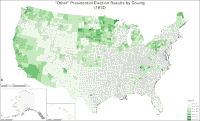
Map of "other" presidential election results by county

Map of Republican presidential election results by county
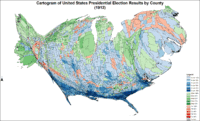
Cartogram (county sizes based on total votes recorded) of presidential election results by county
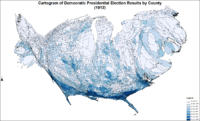
Cartogram (county sizes based on total votes recorded) of Democratic presidential election results by county
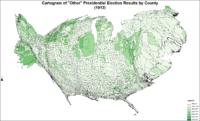
Cartogram (county sizes based on total votes recorded) of "other" presidential election results by county

Cartogram (county sizes based on total votes recorded) of Republican presidential election results by county
Results by state
[27]
| States won by Wilson/Marshall |
| States won by Roosevelt/Johnson |
| States won by Taft/Butler |
| Woodrow Wilson Democratic | Theodore Roosevelt Progressive | William H. Taft Republican | Eugene V. Debs Socialist | Eugene Chafin Prohibition | Arthur Reimer Socialist Labor | Margin | State Total | ||||||||||||||||
|---|---|---|---|---|---|---|---|---|---|---|---|---|---|---|---|---|---|---|---|---|---|---|---|
| State | electoral votes | # | % | electoral votes | # | % | electoral votes | # | % | electoral votes | # | % | electoral votes | # | % | electoral votes | # | % | electoral votes | # | % | # | |
Alabama | 12 | 82,438 | 69.89 | 12 | 22,680 | 19.23 | - | 9,807 | 8.31 | - | 3,029 | 2.57 | - | - | - | - | - | - | - | 59,758 | 50.66 | 117,959 | AL |
Arizona | 3 | 10,324 | 43.52 | 3 | 6,949 | 29.29 | - | 3,021 | 12.74 | - | 3,163 | 13.33 | - | 265 | 1.12 | - | - | - | - | 3,375 | 14.23 | 23,722 | AZ |
Arkansas | 9 | 68,814 | 55.01 | 9 | 21,644 | 17.30 | - | 25,585 | 20.45 | - | 8,153 | 6.52 | - | 908 | 0.73 | - | - | - | - | 43,229 | 34.55 | 125,104 | AR |
California | 13 | 283,436 | 41.81 | 2 | 283,610 | 41.83 | 11 | 3,914 | 0.58 | - | 79,201 | 11.68 | - | 23,366 | 3.45 | - | - | - | - | -174 | -0.03 | 677,944 | CA |
Colorado | 6 | 114,232 | 42.80 | 6 | 72,306 | 27.09 | - | 58,386 | 21.88 | - | 16,418 | 6.15 | - | 5,063 | 1.90 | - | 475 | 0.18 | - | 41,926 | 15.71 | 266,880 | CO |
Connecticut | 7 | 74,561 | 39.16 | 7 | 34,129 | 17.92 | - | 68,324 | 35.88 | - | 10,056 | 5.28 | - | 2,068 | 1.09 | - | 1,260 | 0.66 | - | 6,237 | 3.28 | 190,404 | CT |
Delaware | 3 | 22,631 | 46.48 | 3 | 8,886 | 18.25 | - | 15,998 | 32.85 | - | 556 | 1.14 | - | 623 | 1.28 | - | - | - | - | 6,633 | 13.62 | 48,694 | DE |
Florida | 6 | 35,343 | 69.52 | 6 | 4,555 | 8.96 | - | 4,279 | 8.42 | - | 4,806 | 9.45 | - | 1,854 | 3.65 | - | - | - | - | 30,537 | 60.07 | 50,837 | FL |
Georgia | 14 | 93,087 | 76.63 | 14 | 21,985 | 18.10 | - | 5,191 | 4.27 | - | 1,058 | 0.87 | - | 149 | 0.12 | - | - | - | - | 71,102 | 58.53 | 121,470 | GA |
Idaho | 4 | 33,921 | 32.08 | 4 | 25,527 | 24.14 | - | 32,810 | 31.02 | - | 11,960 | 11.31 | - | 1,536 | 1.45 | - | - | - | - | 1,111 | 1.05 | 105,754 | ID |
Illinois | 29 | 405,048 | 35.34 | 29 | 386,478 | 33.72 | - | 253,593 | 22.13 | - | 81,278 | 7.09 | - | 15,710 | 1.37 | - | 4,066 | 0.35 | - | 18,570 | 1.62 | 1,146,173 | IL |
Indiana | 15 | 281,890 | 43.07 | 15 | 162,007 | 24.75 | - | 151,267 | 23.11 | - | 36,931 | 5.64 | - | 19,249 | 2.94 | - | 3,130 | 0.48 | - | 119,883 | 18.32 | 654,474 | IN |
Iowa | 13 | 185,325 | 37.64 | 13 | 161,819 | 32.87 | - | 119,805 | 24.33 | - | 16,967 | 3.45 | - | 8,440 | 1.71 | - | - | - | - | 23,506 | 4.77 | 492,356 | IA |
Kansas | 10 | 143,663 | 39.30 | 10 | 120,210 | 32.88 | - | 74,845 | 20.47 | - | 26,779 | 7.33 | - | - | - | - | - | - | - | 23,453 | 6.42 | 365,560 | KS |
Kentucky | 13 | 219,484 | 48.48 | 13 | 101,766 | 22.48 | - | 115,510 | 25.52 | - | 11,646 | 2.57 | - | 3,253 | 0.72 | - | 1,055 | 0.23 | - | 103,974 | 22.97 | 452,714 | KY |
Louisiana | 10 | 60,871 | 76.81 | 10 | 9,283 | 11.71 | - | 3,833 | 4.84 | - | 5,261 | 6.64 | - | - | - | - | - | - | - | 51,588 | 65.10 | 79,248 | LA |
Maine | 6 | 51,113 | 39.43 | 6 | 48,495 | 37.41 | - | 26,545 | 20.48 | - | 2,541 | 1.96 | - | 946 | 0.73 | - | - | - | - | 2,618 | 2.02 | 129,640 | ME |
Maryland | 8 | 112,674 | 48.57 | 8 | 57,789 | 24.91 | - | 54,956 | 23.69 | - | 3,996 | 1.72 | - | 2,244 | 0.97 | - | 322 | 0.14 | - | 54,885 | 23.66 | 231,981 | MD |
Massachusetts | 18 | 173,408 | 35.53 | 18 | 142,228 | 29.14 | - | 155,948 | 31.95 | - | 12,616 | 2.58 | - | 2,754 | 0.56 | - | 1,102 | 0.23 | - | 17,460 | 3.58 | 488,057 | MA |
Michigan | 15 | 150,751 | 27.36 | - | 214,584 | 38.95 | 15 | 152,244 | 27.63 | - | 23,211 | 4.21 | - | 8,934 | 1.62 | - | 1,252 | 0.23 | - | -62,340 | -11.31 | 550,976 | MI |
Minnesota | 12 | 106,426 | 31.84 | - | 125,856 | 37.66 | 12 | 64,334 | 19.25 | - | 27,505 | 8.23 | - | 7,886 | 2.36 | - | 2,212 | 0.66 | - | -19,430 | -5.81 | 334,219 | MN |
Mississippi | 10 | 57,324 | 88.90 | 10 | 3,549 | 5.50 | - | 1,560 | 2.42 | - | 2,050 | 3.18 | - | - | - | - | - | - | - | 53,775 | 83.39 | 64,483 | MS |
Missouri | 18 | 330,746 | 47.35 | 18 | 124,375 | 17.80 | - | 207,821 | 29.75 | - | 28,466 | 4.07 | - | 5,380 | 0.77 | - | 1,778 | 0.25 | - | 122,925 | 17.60 | 698,566 | MO |
Montana | 4 | 27,941 | 35.00 | 4 | 22,456 | 28.13 | - | 18,512 | 23.19 | - | 10,885 | 13.64 | - | 32 | 0.04 | - | - | - | - | 5,485 | 6.87 | 79,826 | MT |
Nebraska | 8 | 109,008 | 43.69 | 8 | 72,681 | 29.13 | - | 54,226 | 21.74 | - | 10,185 | 4.08 | - | 3,383 | 1.36 | - | - | - | - | 36,327 | 14.56 | 249,483 | NE |
Nevada | 3 | 7,986 | 39.70 | 3 | 5,620 | 27.94 | - | 3,196 | 15.89 | - | 3,313 | 16.47 | - | - | - | - | - | - | - | 2,366 | 11.76 | 20,115 | NV |
New Hampshire | 4 | 34,724 | 39.48 | 4 | 17,794 | 20.23 | - | 32,927 | 37.43 | - | 1,981 | 2.25 | - | 535 | 0.61 | - | - | - | - | 1,797 | 2.04 | 87,961 | NH |
New Jersey | 14 | 178,289 | 41.20 | 14 | 145,410 | 33.60 | - | 88,835 | 20.53 | - | 15,948 | 3.69 | - | 2,936 | 0.68 | - | 1,321 | 0.31 | - | 32,879 | 7.60 | 432,739 | NJ |
New Mexico | 3 | 20,437 | 41.39 | 3 | 8,347 | 16.90 | - | 17,733 | 35.91 | - | 2,859 | 5.79 | - | - | - | - | - | - | - | 2,704 | 5.48 | 49,376 | NM |
New York | 45 | 655,573 | 41.27 | 45 | 390,093 | 24.56 | - | 455,487 | 28.68 | - | 63,434 | 3.99 | - | 19,455 | 1.22 | - | 4,273 | 0.27 | - | 200,086 | 12.60 | 1,588,315 | NY |
North Carolina | 12 | 144,407 | 59.24 | 12 | 69,135 | 28.36 | - | 29,129 | 11.95 | - | 987 | 0.40 | - | 118 | 0.05 | - | - | - | - | 75,272 | 30.88 | 243,776 | NC |
North Dakota | 5 | 29,555 | 34.14 | 5 | 25,726 | 29.71 | - | 23,090 | 26.67 | - | 6,966 | 8.05 | - | 1,243 | 1.44 | - | - | - | - | 3,829 | 4.42 | 86,580 | ND |
Ohio | 24 | 424,834 | 40.96 | 24 | 229,807 | 22.16 | - | 278,168 | 26.82 | - | 90,144 | 8.69 | - | 11,511 | 1.11 | - | 2,630 | 0.25 | - | 146,666 | 14.14 | 1,037,094 | OH |
Oklahoma | 10 | 119,156 | 46.95 | 10 | - | - | - | 90,786 | 35.77 | - | 41,674 | 16.42 | - | 2,185 | 0.86 | - | - | - | - | 28,370 | 11.18 | 253,801 | OK |
Oregon | 5 | 47,064 | 34.34 | 5 | 37,600 | 27.44 | - | 34,673 | 25.30 | - | 13,343 | 9.74 | - | 4,360 | 3.18 | - | - | - | - | 9,464 | 6.91 | 137,040 | OR |
Pennsylvania | 38 | 395,637 | 32.49 | - | 444,894 | 36.53 | 38 | 273,360 | 22.45 | - | 83,614 | 6.87 | - | 19,525 | 1.60 | - | 706 | 0.06 | - | -49,257 | -4.04 | 1,217,736 | PA |
Rhode Island | 5 | 30,412 | 39.04 | 5 | 16,878 | 21.67 | - | 27,703 | 35.56 | - | 2,049 | 2.63 | - | 616 | 0.79 | - | 236 | 0.30 | - | 2,709 | 3.48 | 77,894 | RI |
South Carolina | 9 | 48,357 | 95.94 | 9 | 1,293 | 2.57 | - | 536 | 1.06 | - | 164 | 0.33 | - | - | - | - | - | - | - | 47,064 | 93.37 | 50,405 | SC |
South Dakota | 5 | 48,942 | 42.07 | - | 58,811 | 50.56 | 5 | - | - | - | 4,662 | 4.01 | - | 3,910 | 3.36 | - | - | - | - | -9,869 | -8.48 | 116,325 | SD |
Tennessee | 12 | 133,021 | 52.80 | 12 | 54,041 | 21.45 | - | 60,475 | 24.00 | - | 3,564 | 1.41 | - | 832 | 0.33 | - | - | - | - | 72,546 | 28.80 | 251,933 | TN |
Texas | 20 | 221,589 | 72.62 | 20 | 28,853 | 9.46 | - | 26,755 | 8.77 | - | 25,743 | 8.44 | - | 1,738 | 0.57 | - | 442 | 0.14 | - | 192,736 | 63.17 | 305,120 | TX |
Utah | 4 | 36,579 | 32.55 | - | 24,174 | 21.51 | - | 42,100 | 37.46 | 4 | 9,023 | 8.03 | - | - | - | - | 510 | 0.45 | - | -5,521 | -4.91 | 112,386 | UT |
Vermont | 4 | 15,354 | 24.43 | - | 22,132 | 35.22 | - | 23,332 | 37.13 | 4 | 928 | 1.48 | - | 1,095 | 1.74 | - | - | - | - | -1,200 | -1.91 | 62,841 | VT |
Virginia | 12 | 90,332 | 65.95 | 12 | 21,776 | 15.90 | - | 23,288 | 17.00 | - | 820 | 0.60 | - | 709 | 0.52 | - | 50 | 0.04 | - | 67,044 | 48.95 | 136,975 | VA |
Washington | 7 | 86,840 | 26.90 | - | 113,698 | 35.22 | 7 | 70,445 | 21.82 | - | 40,134 | 12.43 | - | 9,810 | 3.04 | - | 1,872 | 0.58 | - | -26,858 | -8.32 | 322,799 | WA |
West Virginia | 8 | 113,197 | 42.11 | 8 | 79,112 | 29.43 | - | 56,754 | 21.11 | - | 15,248 | 5.67 | - | 4,517 | 1.68 | - | - | - | - | 34,085 | 12.68 | 268,828 | WV |
Wisconsin | 13 | 164,230 | 41.06 | 13 | 62,448 | 15.61 | - | 130,596 | 32.65 | - | 33,476 | 8.37 | - | 8,584 | 2.15 | - | 632 | 0.16 | - | 33,634 | 8.41 | 399,975 | WI |
Wyoming | 3 | 15,310 | 36.20 | 3 | 9,232 | 21.83 | - | 14,560 | 34.42 | - | 2,760 | 6.53 | - | 434 | 1.03 | - | - | - | - | 750 | 1.77 | 42,296 | WY |
| TOTALS: | 531 | 6,296,284 | 41.84 | 435 | 4,122,721 | 27.40 | 88 | 3,486,242 | 23.17 | 8 | 901,551 | 5.99 | - | 208,156 | 1.38 | - | 29,324 | 0.19 | - | 2,173,563 | 14.44 | 15,048,834 | US |
Close states
Margin of victory less than 1% (13 electoral votes):
- California, 0.03%
Margin of victory less than 5% (142 electoral votes):
- Idaho, 1.05%
- Illinois, 1.62%
- Wyoming, 1.77%
- Vermont, 1.91%
- Maine, 2.02%
- New Hampshire, 2.04%
- Connecticut, 3.28%
- Rhode Island, 3.48%
- Massachusetts, 3.58%
- Pennsylvania, 4.04%
- North Dakota, 4.42%
- Iowa, 4.77%
- Utah, 4.91%
Margin of victory between 5% and 10% (73 electoral votes):
- New Mexico, 5.48%
- Minnesota, 5.81%
- Kansas, 6.42%
- Montana, 6.87%
- Oregon, 6.91%
- New Jersey, 7.60%
- Washington, 8.32%
- Wisconsin, 8.41%
- South Dakota, 8.48%
Statistics
Counties with Highest Percent of Vote (Democratic)
- Greenville County, South Carolina 100.00%
- Marlboro County, South Carolina 100.00%
- Hampton County, South Carolina 100.00%
- Jasper County, South Carolina 100.00%
- Reagan County, Texas 100.00%
Counties with Highest Percent of Vote (Other)
- Scott County, Tennessee 82.80%
- Campbell County, South Dakota 80.42%
- Clearwater County, Minnesota 77.35%
- Avery County, North Carolina 72.84%
- Cook County, Minnesota 72.70%
Counties with Highest Percent of Vote (Republican)
- Zapata County, Texas 80.89%
- Valencia County, New Mexico 77.25%
- Kane County, Utah 75.40%
- Clinton County, Kentucky 64.79%
- Huerfano County, Colorado 63.36%
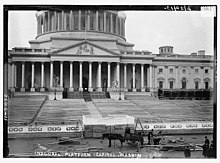
Inauguration platform being constructed in front of the Capitol
See also
- Progressive Era
- History of the United States (1865–1918)
- United States House of Representatives elections, 1912
- United States Senate elections, 1912 and 1913
- First inauguration of Woodrow Wilson
Notes
References
^ "Voter Turnout in Presidential Elections". The American Presidency Project. UC Santa Barbara.
^ Morris, Edmund. Colonel Roosevelt. New York: Random House Trade Paperbacks. p. 215.
^ Coletta, Presidency of William Howard Taft ch 3
^ Anderson (1973), p.79
^ Schweikart and Allen, p. 491.
^ "History, Travel, Arts, Science, People, Places | Smithsonian". Smithsonianmag.com. Retrieved 2016-08-18.
^ "Taft Is Nominated On First Ballot". Santa Cruz News. Santa Cruz, CA. June 22, 1912. Retrieved January 7, 2018.
^ "Taft Wins With 561". The Courier. Harrisburg, PA. June 23, 1912. Retrieved January 7, 2018.
^ Pietrusza, David (2007). 1920: The Year of the Six Presidents. New York: Carroll & Graf. ISBN 0-7867-1622-3.
^ Ira Kipnis, The American Socialist Movement, 1897–1912 1952.
^ "The Bull Moose and related media". Archived from the original on March 8, 2010. Retrieved March 8, 2010.to make sure that no violence was done
^ Remey, Oliver E.; Cochems, Henry F.; Bloodgood, Wheeler P. (1912). The Attempted Assassination of Ex-President Theodore Roosevelt. Milwaukee, Wisconsin: The Progressive Publishing Company. p. 192.
^ "Medical History of American Presidents". Doctor Zebra. Retrieved September 14, 2010.
^ "Excerpt", Detroit Free Press, History buff.
^ ab "It Takes More Than That to Kill a Bull Moose: The Leader and The Cause". Theodore Roosevelt Association. Retrieved October 14, 2015.
^ "Roosevelt Timeline". Theodore Roosevelt. Retrieved September 14, 2010.
^ Timeline of Theodore Roosevelt's Life by the Theodore Roosevelt Association at www.theodoreroosevelt.org
^ Donavan, p. 119
^ "Archived copy". Archived from the original on 2015-09-19. Retrieved 2010-11-09.CS1 maint: Archived copy as title (link)
^ NEW YORK TIMES. (1909, September 19). MR. TAFT'S DECISION. Retrieved February 22, 2017, from https://timesmachine.nytimes.com/timesmachine/1909/09/19/106721681.pdf
^ Fisk, G. M. (1910). The Payne-Aldrich Tariff. Political Science Quarterly,25(1), 35-39. doi:10.2307/2141008
^ Theodore Roosevelt Association. "The New Nationalism." The New Nationalism - Theodore Roosevelt Association. N.p., n.d. Web. 17 Apr. 2017.
^ ab The Presidential Vote, 1896–1932, Edgar E. Robinson, pg. 14
^ abc The Presidential Vote, 1896–1932, Edgar E. Robinson, pg. 15
^ The Presidential Vote, 1896–1932, Edgar E. Robinson, pg. 17
^ Sullivan, Robert David; ‘How the Red and Blue Map Evolved Over the Past Century’; America Magazine in The National Catholic Review; June 29, 2016
^ "1912 Presidential General Election Data – National". Uselectionatlas.org. Retrieved May 4, 2013.
Further reading
- Broderick, Francis L. Progressivism at risk: Electing a president in 1912 (Praeger, 1989).
Chace, James (2004). 1912: Wilson, Roosevelt, Taft, and Debs—The Election That Changed the Country. New York: Simon and Schuster. ISBN 0-7432-0394-1.
Cooper, John Milton, Jr. (1983). The Warrior and the Priest: Woodrow Wilson and Theodore Roosevelt. Cambridge: Belknap Press. ISBN 0-674-94751-7.
- Cowan, Geoffrey. Let the People Rule: Theodore Roosevelt and the Birth of the Presidential Primary (2016).
- Delahaye, Claire. "The New Nationalism and Progressive Issues: The Break with Taft and the 1912 Campaign," in Serge Ricard, ed., A Companion to Theodore Roosevelt (2011) pp 452–67. online
- DeWitt, Benjamin P. The Progressive Movement: A Non-Partisan, Comprehensive Discussion of Current Tendencies in American Politics. (1915).
- Flehinger, Brett. The 1912 Election and the Power of Progressivism: A Brief History with Documents (Bedford/St. Martin's, 2003).
- Flynn, James P. "Eugene Debs and the Politics of Parrhesia." (MA thesis, U of South Carolina, 2015). online
- Gable, John A. The Bullmoose Years: Theodore Roosevelt and the Progressive Party. Port Washington, NY: Kennikat Press, 1978.
- Gould, Lewis L. Four hats in the ring: The 1912 election and the birth of modern American politics (Univ Pr of Kansas, 2008).
- Jensen, Richard. "Theodore Roosevelt" in Encyclopedia of Third Parties. (ME Sharpe, 2000). pp 702–707.
Kipnis, Ira (1952). The American Socialist Movement, 1897–1912. New York: Columbia University Press.
- Kraig, Robert Alexander. "The 1912 Election and the Rhetorical Foundations of the Liberal State." Rhetoric and Public Affairs (2000): 363-395. in JSTOR
Link, Arthur S. (1956). Wilson: Volume 1, The Road to the White House.
- Milkis, Sidney M., and Daniel J. Tichenor. ""Direct Democracy" and Social Justice: The Progressive Party Campaign of 1912." Studies in American Political Development 8#2 (1994): 282-340.
- Milkis, Sidney M. Theodore Roosevelt, the Progressive Party, and the Transformation of American Democracy. Lawrence, KS: University Press of Kansas, 2009.
Morgan, H. Wayne (1962). Eugene V. Debs: Socialist for President. Syracuse University Press.
Mowry, George E. (1946). Theodore Roosevelt and the Progressive Movement. Madison: Wisconsin University Press.
- Mowry, George E. The Era of Theodore Roosevelt and the Birth of Modern America. New York: Harper and Row, 1962.
- O'Mara, Margaret. Pivotal Tuesdays: Four Elections That Shaped the Twentieth Century (2015), compares 1912, 1932, 1968, 1992 in terms of social, economic, and political history
- Painter, Carl, "The Progressive Party In Indiana," Indiana Magazine of History, 16#3 (1920), pp. 173–283. In JSTOR
Pinchot, Amos. History of the Progressive Party, 1912–1916. Introduction by Helene Maxwell Hooker. (New York University Press, 1958).- Selmi, Patrick. "Jane Addams and the Progressive Party Campaign for President in 1912." Journal of Progressive Human Services 22.2 (2011): 160-190.
Wilensky, Norman N. (1965). Conservatives in the Progressive Era: The Taft Republicans of 1912. Gainesville: University of Florida Press.
Primary sources
- Pinchot, Amos. What's the Matter with America: The Meaning of the Progressive Movement and the Rise of the New Party. n.c.: Amos Pinchot, 1912.
- Roosevelt, Theodore. Bull Moose on the Stump: The 1912 Campaign Speeches of Theodore Roosevelt Ed. Lewis L. Gould. (UP of Kansas, 2008).
Wilson, Woodrow (1956). John Wells Davidson, ed. A Crossroads of Freedom, the 1912 Campaign Speeches.
External links
| Wikimedia Commons has media related to United States presidential election, 1912. |
United States presidential election of 1912 at Encyclopædia Britannica
Presidential Election of 1912: A Resource Guide from the Library of Congress- editorial cartoons
- Sound recording of TR speech
Woodrow Wilson Suspends Campaign After TR Assassination Attempt Shapell Manuscript Foundation- OurCampaigns.com overview of Republican Presidential Primaries of 1912
- 1912 popular vote by counties
- 1912 State-by-state Popular vote
- The Election of 1912
How close was the 1912 election? — Michael Sheppard, Massachusetts Institute of Technology- Election of 1912 in Counting the Votes
